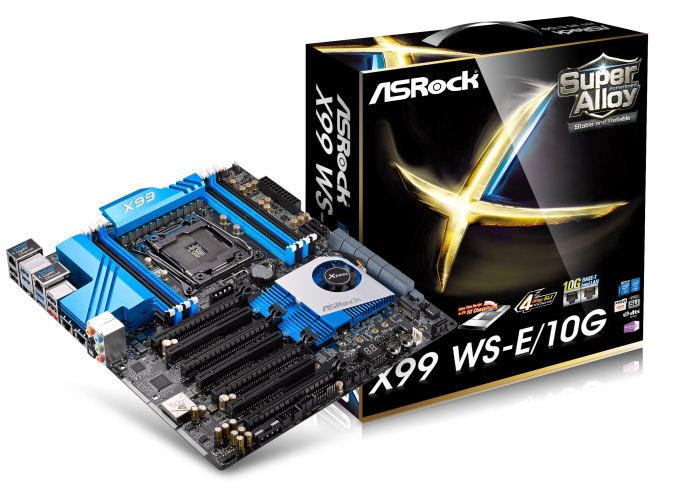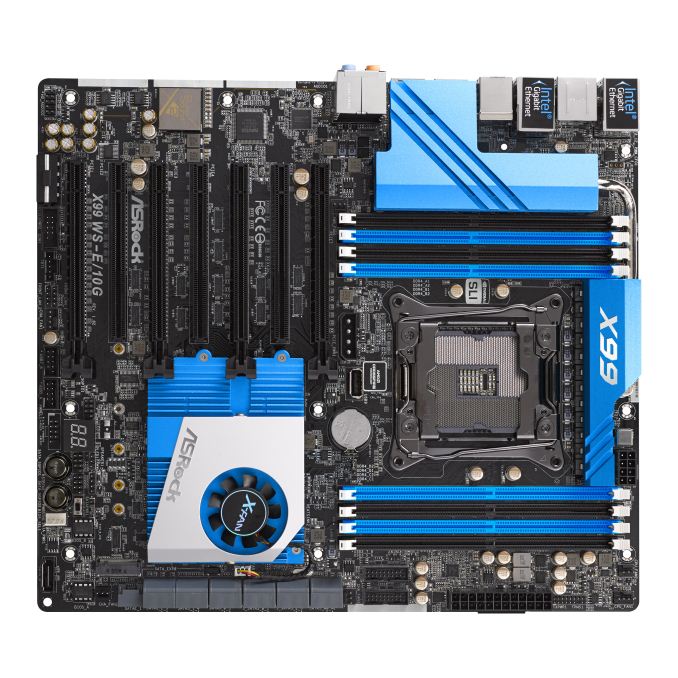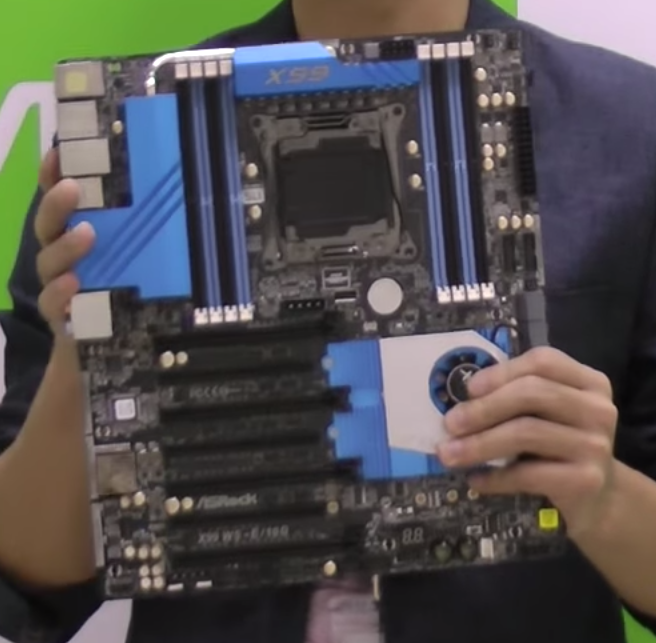ASRock Announces X99 WS-E/10G: Dual 10GBase-T and Quad x16
by Ian Cutress on November 24, 2014 4:06 AM EST- Posted in
- Motherboards
- ASRock
- 10G Ethernet
- X99
- LGA2011-3
- 10GBase-T
- PLX8747

Edit: Read our full review here: http://www.anandtech.com/show/8781/
Regular readers of my twitter feed might have noticed that over the past 12/24 months, I lamented the lack of 10 gigabit Ethernet connectors on any motherboard. My particular gripe was the lack of 10GBase-T, the standard which can be easily integrated into the home. Despite my wishes, there are several main barriers to introducing this technology. Firstly is the cost, whereby a 10GBase-T Ethernet card costs $400-$800 depending on your location (using the Intel X520-T2), followed by the power consumption which requires either an active cooler or a passive plus good airflow to shift up to 14W. The bandwidth can be as important (PCIe 2.1 x8 for the X540-BT2, but can work in PCIe 3.0 x8 or x4 mode), but also it is limited to those who need faster internal networking routing. When all these factors are added together, it does not make for an easy addition to a motherboard. But step forward ASRock.
The concept of the X99 WS-E/10G is simple. This is a workstation class motherboard aimed at prosumers. This is where 10GBase-T makes most sense after all, at the users that have sufficient funds to purchase a minimum $800 Netgear 10GBase-T switch and measure their internal networking upgrades in terms of hundreds of dollars per port, rather than cents per port. The workstation motherboard is also designed to support server operating systems, and is low profile in the rear for fitting into 1U chassis, similar to other ASRock WS motherboards.
In order to deal with the heat from the Intel X540-BT2 chip being used, the extended XXL heatsink is connected to the top heatsink on board, with the final chipset heatsink using an active fan. This is because this chipset heatsink arrangement also has to cool two PLX 8747 chips which enable the x16/x16/x16/x16 functionality. If a prosumer has enough single slot cards, this can extend into x16/x8/x8/x8/x8/x8/x8 if needed. Extra PCIe power is provided via two molex ports above and below the PCIe connectors.
Aside from the X540-BT2 chip supplying dual 10GBase-T ports, ASRock has dual Intel I210-AT Ethernet ports also for a total of four. All four can be teamed with a suitable switch in play. The key point to note here despite ASRock’s video explaining the technology, and which sounds perfectly simple to anyone in networking, is that this does not increase your internet speed, only the internal home/office network speed.
The rest of the motherboard is filled with ten SATA 6 Gbps ports plus another two from a controller, with also SATA Express support and M.2 support. ASRock’s video suggests this is PCIe 2.0 x4, although their image lacks the Turbo M.2 x4 designation and the chipset would not have enough lanes, and as such it is probably M.2 x2 shared with the SATAe. Audio is provided by an improved Realtek ALC1150 codec solution, and in the middle of the board is a USB 2.0 Type-A slot sticking out of the motherboard, for dongles or easy OS installation out of the case. There are eight USB 3.0 ports on the board as well.
Like the X99 Extreme11, this motherboard is going to come in very expensive. Dual PLX 8747 chips and an Intel X540-BT2 chip on their own would put it past most X99 motherboards on the market. To a certain extent we could consider the Extreme11 design, remove the LSI chip from it and add the X540-BT2, which still means it will probably be $200-$300 more than the Extreme11. Mark this one down at around $800-$900 as a rough guess, with an estimated release date in December.
Thinking out loud for a moment: 10GBase-T is being used here because it is a prosumer feature, and prosumers already want a lot of other features, hence the combination and high price overall. The moment 10G is added to a basic motherboard for example, using a H97/Z97 (and reduces the PCIe 3.0 x16 down to x8), a $100 board becomes $400+ and beyond the cost of any other Z97 motherboard. Ultimately if 10GBase-T were to become a mainstream feature, the chip needs to come down in price.











_thumb.jpg)









50 Comments
View All Comments
The Von Matrices - Monday, November 24, 2014 - link
I like the idea of integrating 10Gbase-T and would be willing to pay a $200 premium for it; I just wish it wasn't on a motherboard that was designed with no regard to cost by integrating every other chip imaginable.If they had a cheaper $350-$450 model that had a single 10GBase-T port I would be interested. There already are enough SATA ports and PCIe lanes in the X99 chipset; just add a single port 10GBase-T controller to a mid range board and you have a good product. You can get single port 10GBase-T cards for under $250, and an X99 Extreme3 board for $200, so I don't see how combining the two could be more expensive than that.
r3loaded - Monday, November 24, 2014 - link
Why exactly is 10Gbase-T so expensive, especially when compared to 1000Base-T? Is it because the technology inherently costs a lot to produce? Or is it because the primary customers of the technology regard those prices as pocket change?CaedenV - Monday, November 24, 2014 - link
10gig is expensive because it is impractical. Not that it is unnecessary, because there are plenty of uses for it (could certainly use it in my home), but just impractical over copper. 10meg was fine, and 100 meg was considered pushing copper to limits. 1gig was considered impossible just over 10 years ago, but by upping the power made it work. To get 10gig to work they took that approach to an extreme. You need PCIe lanes, and lots of power to get it to work, and that is just not going to happen on consumer equipment.But we do need a 10+gig solution for home networking. It needs to be affordable, easy to deploy, and low enough power to work with passive cooling in everything from a laptop to a server. I don't know what the answer is, but it certainly isn't going to be twisted pair copper, and optical has its own issues for in-home deployment... no good answers here.
DanNeely - Monday, November 24, 2014 - link
IIRC reading somwhere in the last year that we were one or two process shrinks away from crossing a threshold that should result in much cheaper and lower power 10GBE chips.azazel1024 - Monday, November 24, 2014 - link
Correct. GbE experienced the same thing, though deployment WAS faster, relatively speaking.A dual port solution has a TDP of around 14w for 10GbE right now. 15 years ago, 1GbE had pretty close to the same ~7w per port TDP and required a beefy heatsink or active cooling (a lot of dual/quad port GbE cards neede active cooling until the mid/late 2000's).
10GbE IS coming (to "the home"). Just slowly. I doubt we are 2 years out, but I'd be suprised if we were 5 years out from it being pretty standard on mid/high end motherboards, as well as affordable switches and NICs (by afforable I mean less than $50 per port).
Death666Angel - Monday, November 24, 2014 - link
Personally, I look forward to 1Gb being the norm for all router / modem ports. There are still far too many 100Mbit solutions for the bundled stuff you get from your ISP and even moderately priced routers.Flunk - Monday, November 24, 2014 - link
I don't think that will change too much. The bundled solutions from ISPs are designed to deliver the internet speed you're paying for and no more. If they can save a dollar by only using 100Mbit Ethernet ports they will. You have to buy your own equipment if you want anything good.DCide - Monday, November 24, 2014 - link
There are a lot of ISPs offering over 100Mbps speeds now, with some in fact already offering 100Mbps+ even on their mid-level tiers! So your argument isn't going to hold up for long.BedfordTim - Monday, November 24, 2014 - link
Sadly they are also offering sub 1MBps for a lot of the UK. Some areas get fibre to the cabinet, but plenty of others don't even get a cabinet.JeffFlanagan - Monday, November 24, 2014 - link
Most ISPs don't deliver data faster then 100Mbit, so it would be wasteful to support higher speeds. Nothing is stopping you from connecting a 1Tb switch to your cable-modem like the rest of us do.